#guide animals
Text
Why Writers Should Consider Giving Blind Characters Canes, Guide Animals, or Other Mobility Aids + How To Choose One
(Note: This post is admittedly long and full of information. Make use of the headings to read the parts you are interested in. I have provided many links, which you can read as you go or save for later. I suggest saving this post and taking your time with it. I am also willing to answer any questions for people who have difficulty reading long posts. While I considered breaking this post into parts, I decided to keep all the information in one place for ease of sharing and reference, especially because multiple sections of the post refer to other sections contained within it.)
When I read for blind characters, my most common suggestion for writers is to give their character a cane, guide animal, or utilize another mobility aid. Most stories I beta read feature totally blind characters or people with very little vision, such as only seeing colors. Despite this, it is extremely common for me to suggest giving them a cane or guide animal because they are rarely portrayed using mobility devices. Because this is such a common suggestion, I wanted to create a post about it.
Most of this will be about mobility aids for people who aren’t familiar with them or are still deciding what tools are best for their character. It will also be mostly for modern, realistic, or semi-realistic stories. I will create a separate post for fantasy and science fiction mobility aids, use of magic or magical items, and writing stories set in or inspired by times before formal mobility tools existed. However, I believe this post can benefit anyone who is writing a blind character or anyone who wants to learn more about blindness. Mobility tools are a big part of blind culture, blind communities, diversity of blind experiences, and accessibility.
Learn About Mobility Aids
Here is a comprehensive post by visually impaired fiction writer and blogger @mimzy-writing-online which contains information about canes, O&M, guide animals, etc. If you are not familiar with canes, start there. It contains helpful information for body language, use of canes, and resources for descriptions that any writer will find valuable. The post also has a section on guide animals and sighted guide.
Here is a post I made about crafting fictional guide animals, although I have no experience as a guide animal handler myself. I made sure to research and include links, so it should still be a good starting point. It also has information about differences between service animals and emotional support animals.
Sighted Guide / Human Guide
First, terminology discussion. Sighted guide is a more common term and more examples come up when I search this term. Sighted guide refers to when a person with vision helps guide a blind person. The guide can be abled or also blind themselves. I have guided my friends before and they have guided me. I have often said that, in a way, sighted guide is a misnomer because someone who has less vision or no vision can also guide someone with more vision just as well.
The term human guide makes up for this misnomer by being more accurate. A TikTok by AskABlindPerson or @askablindperson on tumblr, explains this well. Here is a link to the video. The video states the following:
“I’m blind and I definitely prefer to say human guide rather than sighted guide because you don’t inherently need vision to guide and a blind person can do it too. And it doesn’t have to be that the blind person who’s guiding has more vision than the other person either. It can just be that they know the area better than the person they’re guiding, or it could be that they just have better cane skills or independent travel skills than the other person. Because not everybody has equal access to the same exact opportunities for training. So a blind person can also guide, which is why I like to say human guide because it’s more inclusive.”
Not everyone minds which term is used, however. Some people also only use one term because it was taught to them first, rather than because of any particular meaning.
Below are some examples of sighted / human guide and when it is often used.
Here is an article titled How to be a Sighted Guide
Here is another helpful page with information on certain situations such as narrow spaces.
Here is a video by London Vision.
While human guide can be someone’s main mobility aid, it is often used according to the situation.
Situations in which your character might want to use sighted guide include:
-crowds, where a cane might be difficult to use or someone has a companion they would like to avoid being separated from
-while in lines, mostly to provide descriptions of what happens around them or to let them know when to move forward in the line
-ground that is uneven or steep may cause someone to want to use sighted guide rather than a cane, although this will depend on the person. Using a guide and a cane is also possible. A guide animal may go around the obstacle
-when going inside an unfamiliar house or indoor location, usually for locating a specific room
-navigating unfamiliar areas
-public transport
-guide animal handlers may choose to either do traditional sighted / human guide while using the guide animal or give the command for their animal to follow the person without holding onto them
Guides allow the blind person to gain additional information about their surroundings through conversation with the guide. Human guides can also aid in navigation by providing helpful directions or landmarks. Human guides can be used with a white cane or guide animal. They can also be used without any other mobility aid.
People from cultures who place high value on interdependence, especially on family, may wish to use more human guides. People who have anxiety or disorientation may prefer to use human guides or simply travel with someone else for security. Other people who might tend to use more human guides include: people who have moved to an unfamiliar area, people who are losing vision, people who have recently become blind, people with other disabilities or health concerns, or people who prefer the company of others.
In stories, human guides can portray character relationships, establishing trust and respect. Perhaps a character already knows how to guide, showing familiarity with blindness. This mobility tool can display the helpfulness of a stranger or be the start of a meet-cute. Additionally, showing how good or bad a character is at guiding can show compatibility between characters. I also believe that writing guides into a story can allow for detailed visual descriptions or conversation between your characters.
Imagine character A slowly learning to trust character B, culminating in letting that character be a human guide.
Sonar Devices
I wanted to include a section for these because they aren’t often discussed.
Sonar devices are intended as a supplement for use of a cane or guide animal. Unless the sonar and cane are paired together, such as with the WeWalk cane. While they could be used by themselves, this should probably only be with the addition of a guide and in non-crowded, familiar area.
Here is a video review of the Sunu Band by TheBlindLife.
Here is another review comparing two devices: the Sunu Band and the Buzz Clip.
Note how the devices are used, especially with a cane. The cane is used to detect objects from the waist below, whereas the sonar device is used to detect objects above the waist. This includes objects like tree branches.
Sonar devices work by detecting objects in front of the user and giving a tactile alert, such as a vibration. Vibrations increase the closer one gets to the object, giving a continuous vibration when right in front of it. Moving away from the object, such as stepping to the side, will stop the vibration.
This device could allow blind characters to be more active an create interesting opportunities for descriptions.
Why Does My Character Need a Cane, Guide Animal, or Human Guide?
A few reasons include:
1. It will be more relatable for blind audiences if characters move through the world like they do
2. It is more realistic for stories set in our world or worlds meant to be realistic save for a few elements
3. It allows audiences who aren’t blind to understand how blind people move through the world. In the case of sighted guide, it also offers depictions of politely and efficiently offering help to a blind person, which may include not offering help at all.
4. Canes and guide animals give your blind character some visibility, as the cane, and to some extent the guide animal and harness, signify to others that a character is blind or otherwise disabled in some way. As for sighted / human guide, it offers an extra voice for advocacy purposes or the added visibility that someone is being helped.
5. Mobility tools allow blind people to participate more in a world that is rarely accessible for them at a basic level. I almost always find this is true in books as well unless the writer makes a point to include universal design.
6. Mobility aids improve navigation, increase safety, and increase interaction with the world.
Why Would Anyone Need To Know My Character is Blind?
Safety is a big factor.
In this video titled Using A White Cane While Legally Blind by Cayla With a C, Cayla discusses some of the benefits of using a white cane. One of these is that the cane works as an identifier, letting people know the person using it can’t see so other people need to watch out for them. She mentions it is also important for cars and bikers to know cane users can’t see them well or at all, meaning they don’t expect a cane user to move out of the way.
Both Cayla and Molly Burke share in their videos that people are more likely to offer help when they use a cane.
How Do Mobility Aids Help Blind People Navigate?
It depends on what mobility aid is used.
Canes offer more tactile information and direct contact with the environment. Canes allow someone to feel changes in the ground, such as going from carpet to tile. They make it easier to feel steps or broken sidewalk. They allow blind people to be aware of obstacles, such as a chair, rather than simply going around them they way they might with a guide dog. They help blind people locate landmarks they need in order to be oriented in their environment and navigate their way to different places. For example, they may search for a bench, knowing a drinking fountain is across from it.
As for guide animals, because I am not a guide animal handler myself, I wanted to include quotes from a few sources.
The Guide Dog Foundation says the following in a very useful Q&A:
“In short, guide dogs are taught how to find and follow a clear path, maneuver around obstacles, and stop at curbs. They follow their teammate's directions, and they know that they can disobey only in the face of danger.”
And according to International Guide Dog Federation:
“A guide dog is trained to guide its owner in a straight line unless ordered otherwise. The dog will avoid any obstacles en route, above or around you. It will stop at stairs, doors and kerbs. The dog will not decide where to go; it is up to the vision impaired person to instruct the dog on the direction for the dog to go and the dog will safely guide the person as instructed. The vision impaired person will already be familiar with regularly travelled routes and the dog will quickly become familiar with these too.”
And International Association of Assistance Dog Partnership has a page that explains the categories of tasks performed by guide dogs, as well as other types of assistance dogs.
Sighted / human guide can be used with a family member, friend, or helpful stranger. It can be a primary mode of O&M or used when needed, meaning it be used even if someone already has a cane or a guide animal.
Usually, human guide involves contact with the guide. It can also include the guide orienting the person they are leading by describing surroundings such as “there is a bench to the right” or “we’re near the door” or it can involve telling someone where steps are.
How Do I Know What My Character Should Use?
What your character chooses will depend on their lifestyle, level of vision, age, where they live, culture, religion, and their needs as a blind person.
In the post on guide animals, I went over a few reasons someone might choose a guide dog or a guide horse.
Here are some articles about canes vs guide animals. Although the ones I found focus on dogs, I believe many points made about guide animals can be applied to miniature horses as well.
Guide Dogs vs White Canes: The Comprehensive Comparison
The link above includes the following:
“One of the biggest and most obvious differences between a guide dog and white cane is that a guide dog is trained to avoid obstacles along their pathway. A white cane helps locate impediments so that the blind person can decide how best to maneuver around them.”
Another article that may help:
White Cane vs Guide Dog: Why or Why Not?
White Canes and Guide Dogs - What’s Actually the Difference?
Here are some videos:
Guide Dog vs Canes - Pros and Cons by Molly Burke
White Canes vs Guide Dogs by Challenge Solutions
White Canes vs Guide Dogs - Which is Better? 21 Pros and Cons by Unsightly Opinions
Guide Dog vs Cane, Which is better? by Ashley’s Advice
I also wanted to discuss a few more points.
1. Multiple disabilities
People with multiple disabilities may prefer different methods. For example, those who use a stabilizing cane may have different reasons for choosing their mobility aid. I went into that more in this post here.
It would be difficult to cover all other disabilities here, but I will attempt to include some things to consider.
Consider any pain, weakness, or other difficulties your character may have around their hands, wrists, arms. Canes require repetitive use of these areas.
Consider any sensory issues your character has. Sensory issues may come into play with cane vibration and the tactile information given by canes, especially as it differs between surfaces. The video by Challenge Solutions listed above discusses pain caused by vibration and repetitive movement, for someone who already deals with this. It goes into more detail, mentioning that a dog may lessen this difficulty compared to cane use.
Consider phobias or traumas that may make service animals, especially dogs, a bad choice for the character, their loved ones, or community. In contrast, consider how a service animal may help provide comfort to characters with traumas unrelated to animals
I hope that provides a starting point for thinking about how other disabilities may impact someone’s choice when deciding what mobility aid is right for them. I hope this is helpful is choosing a mobility aid for your character.
2. Financial Considerations
Consider financial difficulties. While guide dog schools often provide highly trained dogs, weeks of training, a harness, and some essentials for free, it depends on the school. Some schools may cover the dog’s veterinary care, while others may not. Some may provide one bag of food. Some may cover costs of transportation to the training school, but may not cover the cost of missed work. Challenge Solutions lists several costly areas that go with having a dog, such as grooming or toys.
The amount the training schools cover is so varied that one cannot assume anything about how the blind person keeps up with care of their dog. They may have trained with a school that covers the most costly things, leaving them to buy the occasional treats and toys, while other schools may not cover much after the dogs and handler leave the school, causing financial difficulties that may or may not have been fully anticipated. Financial situations of blind people with guide animals cannot be reliably assumed.
Canes, on the other hand, are a one-time payment per cane, if they aren’t already free. While canes do require replacement tips and while people do go through canes quickly, the cost is not comparable to that of caring for a guide animal.
For writers, it may make sense to have your fictional world contain schools that continue to cover costs over the guide animal’s life. Or perhaps veterinary care is free in that world. Either way, this may be something to consider. The character’s financial situation can show a lot about them and the world in which they live.
3. Additional thoughts about safety and discrimination
Safety has many different connotations in blind communities. Some people consider safety to mean social safety, as alerting others to blindness may explain any behavior that would be considered strange or rude.
Some consider safety to mean physical safety from tripping, falling, running into objects or people, or having them run into you. This is especially important with vehicles.
Still others consider safety to mean being able to navigate and orient oneself, such as when traveling alone.
Some people consider safety to mean interpersonal safety and the fear of being harmed due to being perceived as vulnerable.
Molly Burke mentions this particular subject at around 19:22 to 20:47 in her video here. To paraphrase, she says that having a big dog with her makes her feel safer as a blind person. Molly states that the white cane may increase her vulnerability as it identifies her as a potential target due to her blindness.
I mentioned that it is helpful for people to be identified as blind, such as with a cane and, to a lesser extent, a guide dog. That is still true. This may provide protection by alerting others that they may need to look out for a blind person instead of expecting that person to avoid them or their vehicle.
On the other side, a cane may alert others to vulnerability in a way that is harmful to the blind person. Due to this factor, blind people may feel safer with a guide dog because the presence of a dog may make others hesitate before doing them harm. I am not sure if the same can be said for those with horses, but it is possible horses may still act as a deterrent. In the video by Challenge Solutions, Caitlyn says that while guide dogs are not trained to be guard dogs and should not be aggressive by nature, it can feel safer to travel with a guide dog. Caitlyn says the following: “They are dogs and I would like to think that they would have a protective instinct if a situation arose where that was needed.” She adds, “I think there is more of a protective aspect to guide dog usage than white cane usage. At least I always felt a lot safer with my dog than I do with my cane.”
I also wanted to include thoughts about discrimination.
Some blind people may worry they will experience more discrimination using one mobility aid over another. This may influence their decision. To give brief examples, people with service animals may be turned away from places they are allowed to go. They may need to advocate for themselves more because of this. Another example might be feeling like people judge them or stare at them more when they use a white cane. They may be grabbed or shouted at more often when using a white cane, as described by Challenge Solutions, or they may be ignored or go unnoticed in other cases. In fact, some blind people are only spoken to in public because of guide dogs acting as a conversation starter.
However, feeling invisible in society seems to be a common issue for many disabled people. Some people also talk about being invisible in some areas and uncomfortably visible in other areas. While a blind person’s choice of mobility aid may influence this, the common disabled experience of both invisibility and hyper-visibility might still follow them.
Additionally, myths about blindness, which I wrote about in this post here, may also cause people to accuse cane users of faking if they have residual vision, which can lead to them feeling unsafe or like they cannot use their residual vision without receiving negative attention. This may cause some people to want a service animal, as in the case of a guide dog, some people may assume they are simply walking their dog or training a guide dog. This may be a way some blind people try to avoid being accused of faking blindness. However, blind people with guide animals may also be accused of having a fake service animal or be accused of not really needing their service animal. Additional barriers may include general public ignorance about laws around service animals or differing laws around access per country.
All of the above can put a lot of strain on people who are just trying to get from point A to point B.
Sighted guide may come with some issues as well. Finding someone who is willing to guide and a helpful guide may be challenging unless a blind person is already using a trusted friend or family member. In social situations, other people may misunderstand use of human guide, believing that they should address the guide rather than the blind person. Use of this mobility aid may also come with judgment from others about the blind person being incapable, lazy, or a burden on others. None of these are true, but they can be judgments people make.
Sighted / human guide may be a preferred form of O&M for people who have recently gone blind or are in unfamiliar areas. Additionally, blind people who come from cultures where interdependence is valued may prefer to use a human guide with or without another mobility aid. It is also important to note that the nature of the blind community also celebrates both interdependence and dependence, and these may not always mean the same thing as they do to people who aren’t blind. This is also true when it comes to using mobility tools and techniques.
What Should My Low Vision Character Use?
The majority of blind people have some residual vision, including low vision. Which is part of why most of the blind community doesn’t use canes, along with lack of training. Unfortunately, many people with residual vision are, however subtly, turned away from using canes or other mobility aids. Based on stories from friends, suggestions in this post by @mimzy-writing-online, my own experience, and information online, I will suggest a few reasons this might be the case.
A big reason has to do with believing they have too much vision to require a mobility aid. The idea of not being disabled enough is both an internal an external issue for people with residual vision. This is because people often claim that if a person can see some, they must not require mobility aid. Mobility aids are seen as a last resort, rather than a way to make life easier. This can lead to self-doubt, confusion, or guilt for a blind person. They might feel as if they are ungrateful because they believe other people have it worse. Conversely, some people may have been taught that relying on a mobility tool is shameful, giving up, or reveals a lack of independence. And sadly, some blind people with residual vision may be afraid of rejection or standing out from others.
This leads me into another reason, which is: believing they will experience more discrimination or social exclusion when using a cane. Unfortunately, this can be true. However, it is also true to that not using a cane can cause others to judge someone for things they do or don’t do as a blind person.
Disclosure is an option that works for many. However, blind people cannot always disclose to everyone they interact with, such as to strangers spotting them outside. Disclosure of blindness can also be fraught with accusations of not really being blind, not looking blind, or not being blind enough to count as blind. These accusations sometimes happen when using canes as well. Denial of help, denial of accommodations, and accusations of faking are common.
In some circumstances, the opposite can happen. Instead of being accused of faking, the choice to use a mobility aid might bring about helpfulness from strangers or concern from loved ones. There may be concern that the vision loss has progressed or that something is wrong. After all, suddenly using a mobility tool can inspire alarm in people who aren’t used to them, because the prevailing thought is that mobility tools are only for totally blind people. And the incorrect message behind this is that being totally blind is negative.
Characters choosing to start using a mobility tool could ease themselves and loved ones into it by being open about their plans. They could experiment with cane use, marginally increasing use over time. Or they could simply use a cane as often as they need to, addressing concerns as they are brought up. Portrayal of communication about mobility aids between a blind character and their family could be a lovely addition to a story.
Lastly, blind people are expected to rely on residual vision for as long as possible, in as many situations as possible. Even if it causes pain, disorientation, or anxiety. Even if seeing is exhausting or frustrating. Even if it isn’t safe. However, the other side of this is that many blind people with residual vision enjoy seeing colors or shapes. They may enjoy being able to describe things to friends with less vision.
But their sight may not always be enough to forgo using a mobility tool safely.
It is my opinion that anyone on the blind spectrum or with declining vision can benefit from use of accessibility tools, whether it be learning Braille or training with a cane.
People with low vision can use canes when they feel it is necessary. Examples may include times where they may need extra visibility or extra contact with the ground as they walk. They may choose to use a cane when crossing the street for added safety. Same applies to using stairs. They may bring their cane only to unfamiliar environments or out with them at night. They might feel like using it one day or in one place and not the next. They may have a condition that is not stable from day to day. Overcast weather or dim lighting could make it necessary to pull out a cane. They could simply want to use their cane or decide to leave it at home because they felt like it.
A blind person does not need to a full-time cane-user to be allowed to use one. It doesn’t have to be all or nothing. If they need it, they need it. It is that simple. It will be the same with your low vision character.
Characters may also switch up mobility tools depending on what is best for where they’re going and what is accessible to them. For example, someone may use a human guide for extra safety while in a new city.
Why I Want More Mobility Aids in Media
This is just my opinion, but I would like to see more characters using mobility aids blind people use in real life. This helps to normalize use of these tools for people who are not familiar with blindness. This allows blind people representation that is more true to life. It also adds more detail to stories that wouldn’t otherwise be there.
There is also something off about blind characters who don’t use anything, specifically because most portrayals of blindness involve characters who are totally blind. Why are these characters walking around absolutely everywhere with no familiar way to navigate? Why are tools used by the blind community rejected when it comes to stories about blind characters?
I suspect it is because of a few factors:
1. Not knowing how mobility aids work. Another deterrent could be the difficulties of research and, in live-action media, wanting to avoid training usually sighted actors in use of these mobility tools.
2. Not wanting the blind character to seem too hindered
3. Wanting the mobility aid to be cooler or more interesting if it does exist. This varies by genre and the period in which the piece of media is set.
I find it strange that most stories about blind people do not feature blind characters using tools or techniques blind people use in real life. It sometimes feels as if blindness is a decoration writers add to their story without thinking about how it would impact their character.
My suggestion is to consider the amount of vision your character has, along with their lifestyle, and choose a mobility tool that works for them. I know that some of you are writing characters who can technically move through life without using a mobility aid full time. In these cases, it would be fun to see characters who are transient mobility aid users.
Closing - Not Everything About Blindness is Difficult
I hope this post was informative. I know that some of it may feel contradictory in nature, but that seems to be part of diversity of experience people have with mobility aids. Not everything has to be true for your character or will be true to their experience. Additionally, don’t feel pressure to portray the difficult aspects of mobility aids or being blind in public spaces; it is good to have stories where blind characters are treated well by everyone. There are days when blind people have nothing but lovely interactions with others and when safety is not a concern.
While I mentioned some negative aspects of being blind in this post, there are many positives as well. This can include opportunities to meet new people and have conversations. This can mean getting the chance to use cool gadgets other people don’t get to use. It can also mean being able to experience the world in unique and fun ways, such as noticing little details about the world. It can mean appreciating colors, lights, smells, sounds, or sensations. It can also mean cool navigation tools and techniques.
I will post a part 2 soon. It will include information for writers of science fiction, fantasy, and stories set in historical times. As always, if anyone has anything feel free to share. I will add any responses here as edits to this post.
If you found this post helpful, my pinned post has many more links. I accept asks or messages with questions. I also offer beta reading for blind characters.
-BlindBeta
#blind characters#writing blind characters#ableism#accessibility#white canes#guide animals#sighted guide#mobility aid
1K notes
·
View notes
Note
I would like to know what you think of magical aids for disablilities in a fantasy setting! Things like: A prosthetic that is enchanted to be capable of fine movements. A wheelchair that can levitate. Hearing aids that are powered by a user's innate magic. Blind people with animal familiars that have a magical connection that allows the person to see through the animals eyes. Thank you!
Hi,
I think that magical aids, in general, can be interesting! But the few options you listed point to some issues.
First of all, the blind person magically seeing - don't do this. There's no point in having a disabled character just to make them abled. Consider this post by blindbeta instead, where they go over fantasy/fictional guide animals. Your blind character shouldn't be able to see, that's just disability erasure.
The same point applies to the prosthetic - is magic just the in-universe excuse to give someone a Cool Robot Arm/Leg that is technically a prosthetic but has little in common with the real world equivalent? I recommend going through our #prosthetics tag, but the two important posts you might want to consider: this on upper limb prosthetics, and this on lower limb ones for what people with amputations actually want - and yes, there are major differences between those two kinds of prostheses outside of being different limbs.
As a cane user, I would enjoy a magical cane that can fit into my pocket when I need it to, or one that I could summon out of thin air when my leg or back decide to make me barely able to walk when I'm out. But to be honest, I'm rather boring and to me, it's important that these fantasy/sci-fi equivalents don't turn a cane unusable in other ways. Prime example, canes with those awful "doorknob" handles... that takes me out of the story more than a teleporting cane. Or those canes with swords hidden in them (opinions heavily differ here, me personally I'm not a fan), like structural stability of the thing aside, if I'm using the cane then I'm definitely not in a condition where I could swing a sword, lol…
A cane that doesn't need changing the damn tip so often, or self-cleans every time I step into something gross would be great too. Or maybe one that is harmless to the user but bites people who touch it without asking!
mod Sasza
I don’t love the idea of a wheelchair that can levitate. Why should disabled people have to change our aids rather than the world becoming more accessible. Don’t get me wrong! There are still fun things you can do with wheelchairs in fantasy. For example a wheelchair with a spell that makes terrain (grass rocks etc.) a typical wheelchair would have trouble navigating flat. A power-chair that doesn’t use a battery but some other form of magic etc. I would challenge you to get creative and think outside of just levitation!
Mod Patch
I love the thought of magic aids. I agree with Sasza of the aspect of aids automatically cleaning themselves or having parts that you don't have to replace constantly. I know for me wiping down my wheelchair was always a hassle and the rubber handles on my breaks wore down constantly (my dog ate them one time) and were very hard to use with wrist that easily subluxed.
Aids that are battery powered running on magic or some other fantasy power source as a sorta battery would be so cool. A Port that magically accesses/de-accesses itself at the person's will? Oxygen Cannulas that never need changing/change themselves? A VP Shunt automatically adjusting its pressures to what the person needs? So many endless things you can do with them!
Mod Virus
I’m not entirely sure what is meant by hearing aids powered by innate magic. If that means never having to deal with replacing the batteries, sign me up! If it means anything other than that, I want more information on what exactly it entails.
Magic aids that function the same as not having a disability at all are erasure, plain and simple.
Mod Rock
#anonymous#mod sasza#mod patch#mod virus#mod rock#disability erasure#fantasy setting#magic aids#fantasy tropes#guide animals#wheelchairs#canes#hearing aids
92 notes
·
View notes
Text
Homebrew Feat: Familiar Guidance
I’m not actually sure if this is worth or would need a feat, but, for reasons, I was looking at the feasibility of using a familiar as a rather more literal seeing-eye animal? For a blind or deaf PC, or a PC who doesn’t have darkvision, for example. And you can use the familiar’s senses as part of the spell itself, it’s just a little clumsy long-term:
While your familiar is within 100 feet of you, you can communicate with it telepathically. Additionally, as an action, you can see through your familiar's eyes and hear what it hears until the start of your next turn, gaining the benefits of any special senses that the familiar has. During this time, you are deaf and blind with regard to your own senses.
An action and it only lasts a turn. So. A feat to make that a little more feasible longterm? For if you do want to play a blind character with a little mouse familiar that sits on their head, or an owl that sits on their shoulder, and lets them use its eyes as their own pretty much continuously.
(I realise this might be slightly overpowered on, say, a bat familiar, giving 60ft blindsight, or even the owl giving essentially superior darkvision, but … that might be worth spending a feat? Also, I’ve put it so you have to be touching the familiar for this to work, so while you’re using them as eyes they can’t do a lot else)
FEAT: FAMILIAR GUIDANCE
You gain the companionship of a familiar, with whom you have a special supportive bond. When you take this feat, you gain the following benefits:
You learn the Find Familiar spell, which you can cast only as a ritual.
If your familiar takes damage while they are within 100ft of you, you can use your reaction to take that damage yourself instead.
While you are in physical contact with your familiar, you can use their senses as if they were your own, without requiring an action. While sharing your familiar’s senses in this way, you gain the benefits of any special senses the familiar has, and you are blind and deaf with regard to your own senses. As your familiar is sharing your space, you can use their senses for any action, such as casting a spell or attacking, that would require your own.
#d&d#5e#homebrew#homebrew feats#find familiar#guide animals#guide familiars#disability aids#magical edition
40 notes
·
View notes
Text
RESOURCES FOR POSES
Line of Action

JustSketch.Me

PoseManiacs

Human-Anatomy-For-Artist.com

MagicPoser
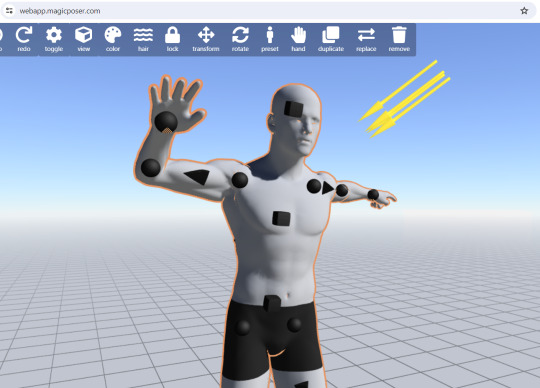
MIXAMO

Pose Archives

Bodies in Motion
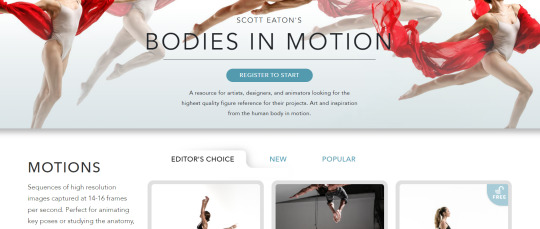
Posemy.art
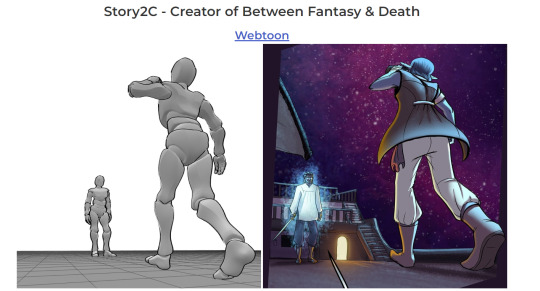
ReferenceAngle
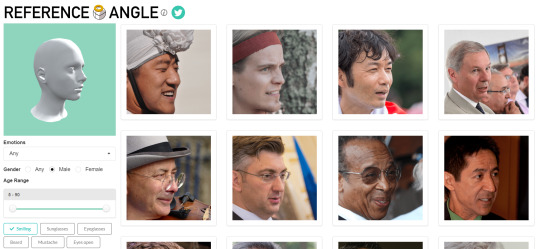
CroquisCafe
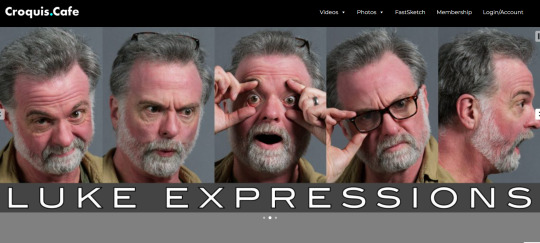
#reference#tutorial#art reference#anatomy#art#poses#artist#art resources#resources#web#pages#help#guide#action#line#figure#body#muscles#human#animal#animation#photography#3d model#angles#views#expressions#faces#emotion
4K notes
·
View notes
Text

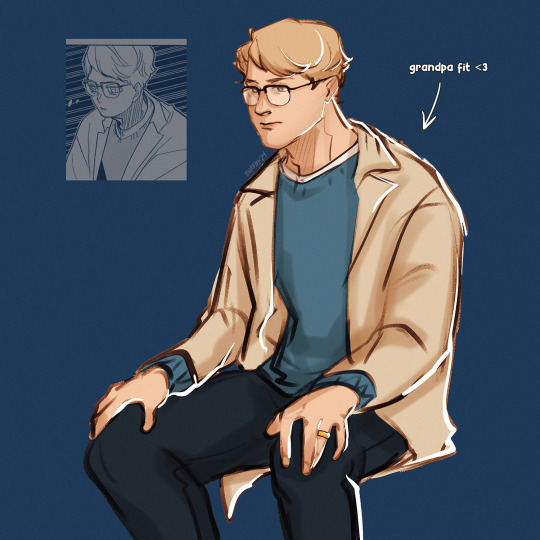
my darling tsukki!
#i still can't believe he works at a museum in post-timeskip like?? that's so fitting???#my dinosaur loving dinosaur living his dream as a curator/tour guide?? good for him#i can imagine tsukki stoically explaining sculptures and paintings but his eyes are all lit up when they reach the dinosaur section LMAO#i'd give tsukki all the strawberry shortcakes in the world!!!!!!! ILOVEHIMSOMUCH!!#my art#2024#haikyuu#haikyuu!!#hq#hq!!#tsukishima kei#tsukishima#haikyuu tsukishima#haikyuu tsukki#tsukki#kei tsukishima#art#fanart#digital art#digital drawing#anime#manga#sketch#doodle
2K notes
·
View notes
Text

Tsubaki (Blue Archive) Drawn By Yasojima Nejiro (Twitter)
#Tsubaki#Tsubaki Blue Archive#Blue Archive#BlueArchive#Tour Guide#Pantyhouse#Short Hair#From Below#Twitter Anime#Anime
1K notes
·
View notes
Text
Trying my best to make this look smooth
I failed 😔
#fyp#hazbin hotel vox#hazbin hotel alastor#voxal#staticradio#staticlovetune#hazbin hotel#animation#i need more guide#😭
2K notes
·
View notes
Text
The (Hopefully) Comprehensive Guide to Drawing Transformers! [1]
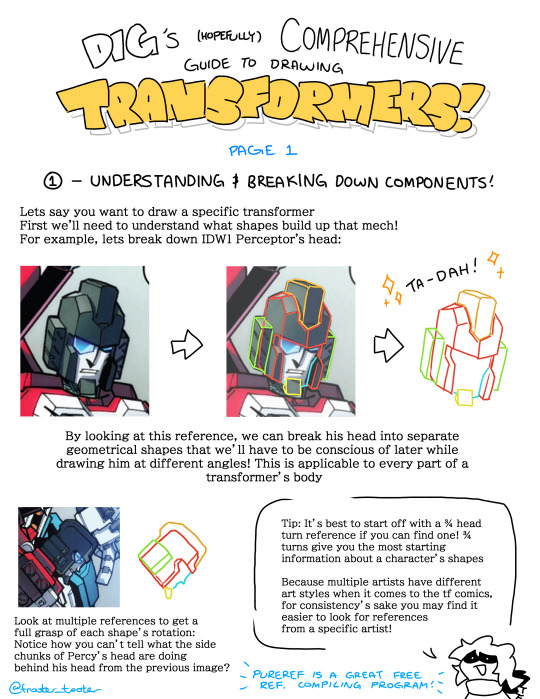
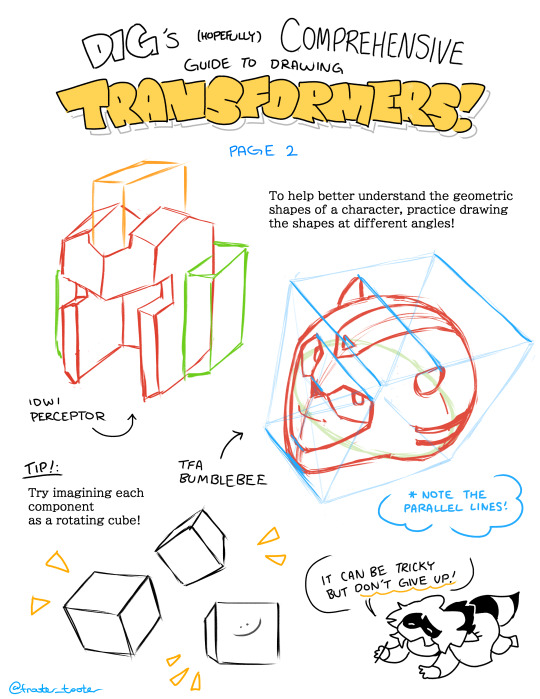
[Chapter 1/5?]
Decided to make a little quick guide to drawing transformers/humanoid mechs because some people asked! (Plus I thought it'd be fun lol) .... Hopefully it makes sense and helps some people out :'D
[Next] -> coming I dunno when, I keep adding to my WIP pile......
#class got cancelled this morning so I finally had a little free time eheh#also the sketches on page 2 are probably not really accurate but hopefully it gets the idea across skdfskd#I banged it out in a few minutes lmao#gotta get back to the work grind now...#WHAT DID I TELL MYSELF ABOUT MAKING MORE WIPS AGHHHHHH I KEEP DOING IT#Dig's (Hopefully) Comprehensive Guide to Drawing Transformers#transformers#mtmte#maccadam#maccadams#tf idw#transformers fanart#more than meets the eye#frootertooter archive#lost light#perceptor#bumblebee#tfa#transformers animated#tfa bumblebee#mecha art#mecha
1K notes
·
View notes
Text
For anyone who makes Gravity Falls fanart, having this is absolutely AMAZING!
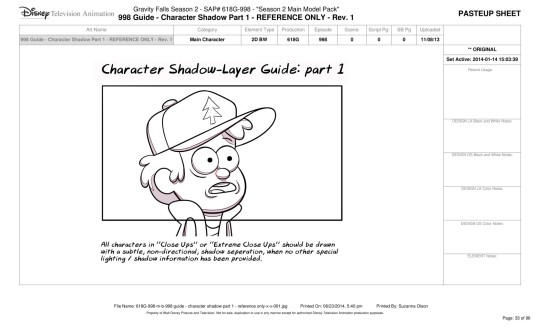









#gravity falls#alex hirsch#gravity falls fandom#gravity falls fanart#gravity falls model guide#art#animation#disney
967 notes
·
View notes
Text





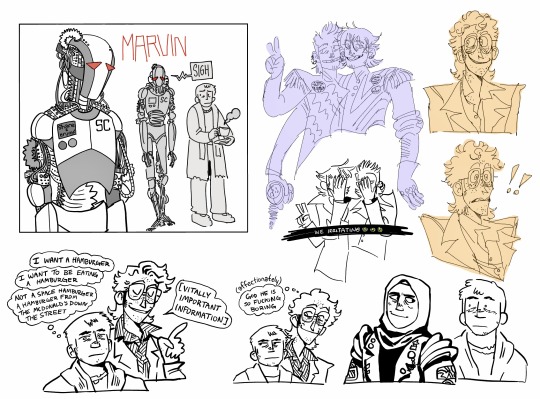
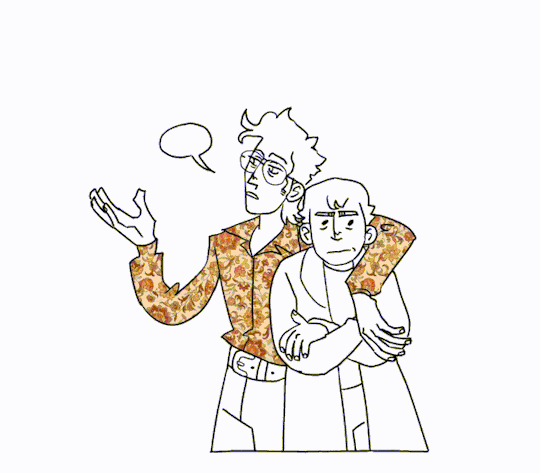
On request, some of my old Hitchhiker's Guide doodles! This series had such a huge impact on me, I love it so
#the hitchhiker's guide to the galaxy#h2g2#ford prefect#arthur dent#zaphod beeblebrox#my art#my animation#should I post my bad hitchhiker's guide ELO amv. speak now or forever hold your peace
2K notes
·
View notes
Text
PICK A CARD: What they want to say to you
Hello and welcome to this new post of mine! I will give you a reading on what certain people want to say to you even though they’re afraid to do so for whatever reason. I hope you guys enjoy and find this interesting.
Masterpost > Paid Readings

~pick a card~
Pile 1:
This message to you is from a parental figure with a masculine energy. They want you to know that they’re incredibly proud of you and that they see how much you’ve progressed over the years, how much you’ve grown and how much you’ve endured. They want you to know that they think you’re incredibly strong and that they look up to you due to how well you’ve been keeping your head high in difficult situations.
This parental figure wants to apologise to you as well; they are aware they aren’t the best at communication, at making clear what it is they feel and what it is they think of you. They also hope you can forgive them for all the faults they’ve made over the years, and some hope you’ll be able to give them a second chance.
Pile 2:
This is a message to you from a younger person with feminine energy, for most of you this being a sibling. They want you to know they look up to you and that you’re really cool and a super hero as well. They want to thank you for all it is that you’ve done for them, and that they hope you’ll continue to spend time with them even if the communication lessens a bit over time.
They love seeing you happy and wish to continue seeing you happy; you deserve to be happy because you’ve made them happy countless of times before. They are proud to know you and be connected to you; they even speak fondly of you to their friends sometimes because they look up to you so much.
Pile 3:
This message is from an animal (didn’t expect an animal to come by). Keep in mind that you don’t need to have a pet to be able to resonate with this message; there are animals all around us, and many of them will have seen you a lot of times even if you haven’t paid attention to them before.
This animal wants you to know that they see and notice you having difficult moments, that you’re hurting and sometimes feel hopeless in all it is you need to do, what is expected from you and how you feel. They want you to know that you’re allowed to cry, allowed to pity yourself, especially if you don’t believe you have it hard enough to feel that wat. That everything will be okay and that you’ll eventually find your way through life, just like they did. You will be free and have fun eventually, and that you must not give up to finally feel all what life is about.
#pick a card#pick a pile#pac#pick an image#pick a photo#spirituality#spiritual#tarot#tarot reading#tarot readings#tarot deck#tarot cards#tarotoftheday#daily tarot#tarotblr#tarotcommunity#divination#channeling#channeled message#channeled reading#channeled messages#spirit team#spirit guides#love reading#future spouse#familiar#loa#spirit animals#family#free tarot
564 notes
·
View notes
Note
hi, this is like, a REALLY oddly specific question, but i wanted to ask. would it be seen as wrong if i were to have my character's guide dog be in some way magical?
for more context on the specific situation, my characters are in a world where basically nothing is without some level of magic to it. my character has a guide dog, but i felt like it didn't fit the theme to have just. a normal dog? because i wouldn't put a normal dog somewhere else. the dog isn't like, telepathic or able to fix her blindness, (ive made it VERY clear to myself that at no point will i do that) i was mostly thinking something like the dog having some sort of elemental component to it, which would be a pretty common power in this world.
I just wanted to make sure it fit in with the rest of the characters in its world, instead of sticking out as just kinda being shoved in with no worldbuilding around it. there wouldn't really be 'normal' animals normally, so it feels like underdeveloped worldbuilding if i don't.
I'm worried though, that this is going to be wrong in the way that it'd seem... glamorizing? that's not what i intend, but I don't want it to come off as something in that vein. if that makes sense.
i hope this is like. sensible to ask about and not wasting your time. thank you so much, and thank you in general for running this blog, i think it's a really great resource.
I think having a magical guide dog is fine. You aren’t using the magic to erase the handler’s disability, as you mentioned. As long as you are actively working on that, it seems fine to me.
As long as the animal can make a good guide, be trained from infancy, and can navigate well, it doesn’t matter if they are a magical creature.
I list some qualities a guide should have in this post if it helps.
@moth-time created an excellent addition to this post in the notes:
i reread the guide linked by OP and now I'm thinking some kind of earth elemental or otherwise particularly magically heavy/stocky dog could be neat, bc it provides more stability than a regular dog (so more like a miniature horse). it could have a rocky/armored back that is easier to lean on than slippy dog skin, for example. Much like irl certain dog breeds are favored as guide dogs bc of breed specs, a magical universe could favor "earth elemental dogs" for same reason
you could have some magical component of the dog be helpful to the guided person, though i am struggling to come up with a good one for a blind guide dog. But for example a fire elemental therapy dog that can regulate it's body to be toasty warm and offer deep pressure and temperature therapy would be neat. It doesn't negate or "fix" the disability, but it's a little different/more magical while still recognizable
BlindBeta’s thoughts:
So I love this. An earth type dog would add excellent stabilization, orientation, and be additionally good at avoiding obstacles such as uneven ground. They could be great for balance and probably deep pressure therapy as well. Maybe they are favored as guide dogs because they are dependable, while also good at selective disobedience to keep a blind person safe, such as refusing to cross the street when it is dangerous (due to quiet cars or such). I could also see water or air type dogs being good alert dogs, perhaps.
Also not sure how common this is, but on this page about seizure alert dogs from the epilepsy foundation, it says some dogs are trained to put their body between the handler and the floor to cushion falls. Air type dogs might good at this because they are probably softer and could gently cushion a falling person without them hitting the floor.
I also had an idea that wood types might be more flexible and good assistance dogs for older adults, wheelchair users, etc. Like dog breeds, they have certain qualities that make them good at assistance, such as being depended on to retrieve any number of items, pull door handles, etc.
This is fun. I would love to see ideas from anyone else.
37 notes
·
View notes
Note
heyy so im writing a character that's blind and she uses a white cane, and during one of her missions (she's part of a spy ring) she's gonna get hurted and is gonna need to use a cane (a walking stick) permanently. so how would she act in this situation where she basically needs to different types of cane to keep her mobility? or do you have any other sugestion about what to do in this situation?
Hi! Thanks for asking.
In this situation, she would likely need to have two canes; both a white cane and a walking stick, used in different hands. The two canes are so different that one came can’t really serve both functions, so she’d need to have one of each. This would of course leave her without a free hand most of the time, so she may want to prioritize using backpacks more than other kinds of bags that would require a free hand. It may be useful to research the experiences of double crutch users to get more ideas for how she would manage things with no free hands.
Depending on exactly what her physical support needs are, she might instead use a guide dog that has also been trained for mobility assistance or counterbalancing. Most guide dog schools can provide some cross training on tasks for additional disabilities, though you will want to research mobility assistance dogs to see if the kinds of tasks a dog can do would be useful for her particular disability. If her particular needs will be met by mobility tasks, then it’s entirely possible to have a guide dog that is also trained in those additional tasks.
Using a guide dog that is cross trained for mobility support would solve the no free hands problem since it only requires one hand, but a guide dog is definitely a very different travel style from a white cane, so you will want to really think about if she as a person would want to switch to a guide dog travel style. It’s a very personal and individual choice, and one is not inherently better than the other, so the switch shouldn’t be made casually. It’s entirely possible that she would be interested in switching to a guide dog lifestyle, but it’s also entirely possible that she would much prefer to use her white cane along with another mobility aid, instead.
One other option could be to use a white cane with a wheelchair depending on the nature of her injury. It sounds like something like a walking stick or mobility assistance dog would be better based on your ask, but if there is more information that might make a wheelchair relevant, that can also be an option. It can be somewhat harder to use a white cane with a manual wheelchair, so many people prefer to use a power chair with a white cane, but a manual chair can absolutely be done if a manual chair would suit her lifestyle better.
If there are any blind and multiply disabled people or physically disabled people (especially those who use mobility assistance service dogs) who would like to chime in in the notes, please do!
Hope this helps!
— mod Lane
#mod Lane#guide animals#blindness#writing blind characters#blind characters#mobility aids#white canes#canes#wheelchairs#service animals#mobility assistance dogs#writing multiply disabled characters
147 notes
·
View notes
Text
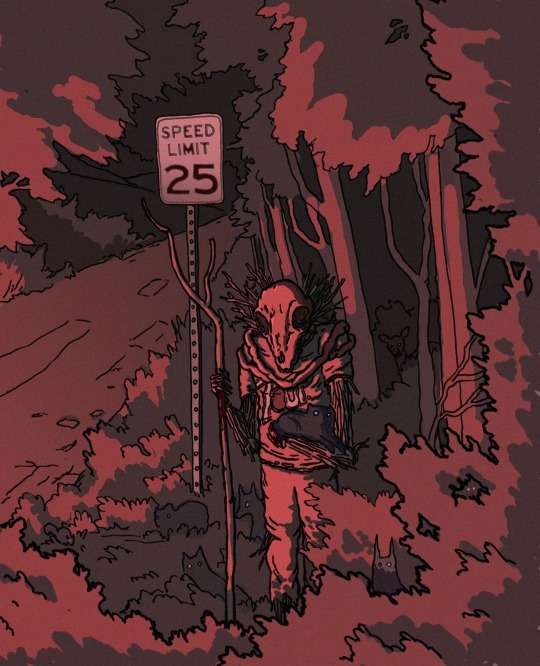
Patron Saint of that blind spot on the road
810 notes
·
View notes
Text
Warrior Bites: Dietary Needs
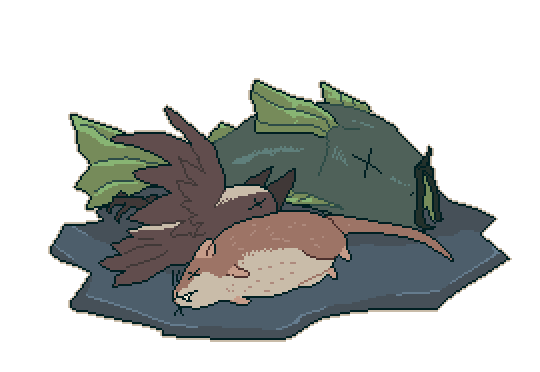
[ID: A fish carcass, bird carcass, and mouse carcass on a stone slab.]
Are you wondering how much prey a Clan needs a day? What they should eat to stay healthy? Why food processing is useful at all? All the answers to these questions and more, contained within a general guide to dietary needs for your Warrior Cats!
As an obligate carnivore, a cat's entire diet revolves around processing meat. More specifically, the ideal diet should be 55% protein, 45% fats, about 1% to 3% carbs, with the remainder being various micro-nutrients. You can expect the average 10-pound warrior to need 350 calories per day, about 3.5 mice on average.
I've also included a section talking about obesity, which dives into how canon's depiction of it is both harmful fatphobia and wouldn't make sense from a cat perspective. It also discusses obesity in realistic cats; and how you're free to choose the realism on that aspect.
Below the cut;
Caloric Intake
Nutrition
Food Processing
On Obesity
Caloric Intake
The general rule for how much a cat needs to eat is that an active, non-neutered tom will need about 35 calories per pound of their own body weight, per day, just to remain the weight they are.
That means that the average warrior, assuming they are 10 pounds, will need 350 calories a day.
Kittens, pregnant and nursing cats, and large warriors will need to eat more than average. Neutered cats, elders, and clerics/medcats will eat less. There are calculators online for determining how much an individual will need, but you can estimate how much an entire Clan will need just by taking 350 and multiplying it by population!
Assuming the average population is about 30 cats, that's 10,500 calories to feed a Clan for a day! To put that in perspective, that many calories would feed 7 large humans. If you felt like fighting a group of angry cats to steal their day's worth of mice, I mean.
Generally speaking, land prey will have a caloric value around 5 calories per gram. Aquatic prey is significantly lower, around 4 calories per gram. Birds will be just below 6 calories per gram. To find out how many cats a piece of prey will feed, or how many pieces a cat will need that day, take the category and multiply by the prey's weight in grams.
So for example, the average house mouse is 20 grams and it is land prey, meaning its caloric value is around 100 calories! A warrior will need 3 and a half mice a day to stay healthy, and a Clan will need 105 mice daily to support 30 cats.
105 mice may seem like a lot, but remember that a wild rabbit is 1,800 grams on average which means 9,000 calories. 2 big pieces of prey will feed the whole Clan, with leftovers.
Those estimates include every part of the animal. Cats eat organs, small bones, and even skin. Skeletal muscle, or "fillets" in reference to fish, is so low in calories that it's typically somewhere between 1 kcal to 1.5 kcal per gram. That's what you're buying in the supermarket; but wild animals don't usually cut their food into choice strips.
(unless you're writing a clan that does food processing of course!)
QUICK FACTS
Average warrior will need 35 calories per pound of weight
10 pound warrior needs 350 calories a day
350 x 30 cats = 10,500 calories to feed a Clan for a single day
Birds provide the most calories per gram, land prey the middlemost, and aquatic prey the least.
Calculate calories in prey by taking the weight, converting to grams, and multiply by 4, 5, or 6 depending on broad category.
If you're having trouble feeding a Clan on small animals, look at bigger prey like rabbits and trout.
Muscle fillets are inferior to organ meats and have a much lower caloric value.
Nutrition
Not all food is the same. The more important thing to consider about any particular meal is NOT its calorie count, but its nutritional value. This is especially important to cats because protein is not stored as fat. If the body has no immediate use for it, it's flushed out.
Since cats should not eat more than 3% carbs, ALL of their fat stores will need to come from fat.
The ideal piece of meat would be at least 55% protein and 45% fat. Every individual species will have a different ratio, and more importantly, individual cuts will have a different ratio.
Skeletal muscle has a higher ratio of protein to fat. Organ meat, also sometimes called "offal," will have a more balanced ratio. That said, nearly all meat skews towards protein. PURE fat is very hard to find on the sorts of animals Clan cats hunt, and must be carefully divided, collected, or processed to make sure all warriors are getting proper nutrition.
I'll be going more in-depth with dietary fat at some other time, as this guide is meant to just be an overview! Just know that some Clans will need to eat MORE food to stay healthy because of this.
Cats need more than the "macronutrients" to stay healthy. They can't JUST rely on the juiciest cuts of meat to keep their health intact, they also need several vitamins and minerals to support their body functions, and avoid getting a deficiency.
Here's some of the important micronutrients, where to get them, and what happens they don't get enough;
Vitamin A: Livers, mealworms, eggs
This is one of the most important micronutrients in a cat's body, used for practically everything. Without this, their coats will grow dull, and their joints stiff, and they'll start to go night-blind. In a severe state, they'll start to lose the ability to heal skin lacerations and die. Pregnant cats and kittens need more of this than usual, but it IS also possible to get vitamin A poisoning from getting too concentrated of a dose.
Calcium: Bones, eggs
With a calcium deficiency, the warrior will feel stiff and sore, and experience painful muscle spasms. Most cats will simply crunch the bones of small prey and never have to worry about this, but if your cats cook or scavenge, they have to be told to NEVER eat the bones of a roasted bird. Because bird bones are hollow and cooking makes them brittle, they can splinter and cause fatal internal bleeding.
Thiamine: Trout, boar meat, mealworms, eggs
Called a Fish Seizure because raw carp and raw bream contains thiaminase, which will destroy thiamine in the body. Lack of thiamine will cause neurological issues, such as the aforementioned seizures, general confusion, memory loss, and muscle weakness. This can be counterracted by eating trout, which is so high in thiamine that there's a theory that carp evolved it specifically to eat salmonids better.
Potassium: Trout, boar meat, mealworms, eggs
As cats get older, they begin needing a lot more potassium for their bodies. It's a very common micronutrient found in most meat, but elders should get the first bite of special snacks "out of respect" which helps keep their potassium level up. Without it, they become very weak.
i feel like that evil struthiomimus from land before time with how many times i typed eggs
QUICK FACTS
The ideal ratio of a cut of meat is 55% protein 45% fat
Organ meat > Muscle meat
Micronutrients are important
But micronutrients can also cause poisoning if, somehow, they're too concentrated
(very hard to come across concentrated micronutrients without the science of chemistry tho. Like if a cat swallowed a vitamin gummy.)
Food Processing
"Food Processing" is when you do something to your food before you eat it. Just a little bit of care is going to go a LONG WAY when it comes to health of the warrior.
Cats that eat raw meat the way canon warriors do are almost guaranteed to get worms. Roundworms, hookworms, and tapeworms are all passed through the infected tissue of rodent prey, and in fish, roundworms, tapeworms, and flukes can pass through raw meat.
All parasites do something a little different, but most digestive worms aren't fatal unless the cat is sick or a kitten. However, nearly ALL of them screw around with digestion, making the cat need to eat more just to stay healthy, or causing stomach irritation. Some of them can even pass in milk, infecting a suckler's nursing kits.
The easiest way to reduce this kind of infection is simply to slice the prey open from mouth-to-butt, Tigerstar-style, and hook and lift out the GI tract before eating. There's nothing in that worth eating raw anyway. It can just be discarded, or cleaned out and used to case tiny sausages! But it's only a reduction; there's still a risk of catching worms from raw meat.
There's also always the possibility of getting salmonella poisoning.
Many believe that cats are immune to this, but that's not true! Carnivores just have a shorter GI tract than omnivores and herbivores, so salmonella spends less time in their gut and ergo has less chance of causing an infection. It still happens, ESPECIALLY when cats hunt songbirds.
Nothing can be done about salmonella in raw meat, besides eating it as quickly as possible. It's innate to the bodies of birds and reptiles, and usually found on raw eggs too.
Some animals are small enough to be dried and carried around as rations, such as minnows or grasshoppers. Others could be sliced up into strips, and marinated in spices like valerian or catmint for an extra boost of energy. It could also be worthwhile to cut the pelt off a particularly soft animal, like a mole, to dry and keep as bedding material.
All of the above examples of food processing are possible without fire, but if your cats DO have fire, they will have a DRASTIC increase to the quality of their health.
Such as;
Cooking will almost completely eliminate those foodborne parasites. Their eggs don't survive extreme heat.
No more salmonella poisoning! GONE! Cooking is the only way to eliminate this!
It can increase caloric absorption from anywhere between 20% to 50%. Our example warrior who needed 3.5 mice a day could suddenly need one less mouse; and even a meager 20% drop in how much the entire Clan needs saves 2,400 calories a day. 24 whole mice!
I HAVE TO STRESS HOW BIG THAT IS. You save anywhere from 2/10 to 5/10 successful kills.
Thiaminase is destroyed by cooking, making bream and carp healthier and reducing "fish seizures."
It allows for fats to be processed and stored as tallow, lard, and oil, so it can be added to other dishes to make them both healthier and tastier.
Most food preservation requires fire in some way; by heating, jellying, boiling, etc. The only other two ways to reliably store food is by having access to a ton of salt, which is hard for most non-coastal clans to acquire, or vinegar, which is so acidic it's a notorious cat-repellent.
While cooking can also destroy some micronutrients, its benefits FAR outweigh any potential "strengths" of raw food. Destroying micronutrients is also not always a bad thing; as TOO MANY micronutrients can cause poisoning. Fire-using Clans will be more likely to "seek" micronutrients than non-fire Clans as a result, though they probably won't recognize the science behind a hankering!
QUICK FACTS
Worms. Basically unavoidable if your cat's eating like a canon warrior.
Some parasites can spread through milk.
Slicing and lifting out the GI tract can significantly reduce the chance of catching worms.
Salmonella can only be eliminated with cooking
Cooking will drastically increase the quality of a Clan's health, if your cats are advanced enough to figure out fire.
Warriors need to hunt a LOT less prey, and can store that prey, if they have fire.
Fire-using Clans will intentionally try to put more types of food in their diets and get 'cravings.'
On Obesity
Warrior Cats is not a realistic series. The boundary that any particular writer draws between humans and warrior cats is completely arbitrary. The series itself follows no sense of realistic genetics, regularly shows the cats using herbs that would poison them, and gives the characters human-centric morals like monogamy and paternal involvement.
So when it comes to being fatness in your project, please keep that in mind. You do not need too follow realistic cat weight distribution, if that's not what your project about. That said, let me tell you about humans vs cats in this department!
Humans have a massive diversity of weight distribution, with varied genetic predispositions to gaining and losing weight. The shame, bullying, and medical discrimination that comes with fatphobia is a LOT more harmful than being fat itself, and the causes of the "obesity crisis" are ridiculously more complicated than "ppl r snorking 2 much food".
Realistic cats aren't the same way.
When REAL cats are fat, that's VERY bad. It's a sign they are being fed the wrong things by humans, or live somewhere that they are able to eat what they shouldn't. They just don't have that same diversity in fat distribution that humans do. Because of how adipose tissue secretes certain hormones, feline obesity is like a chronic inflammatory disease which can cause arthritis, bladder stones, hepatic lipidosis, and more.
But with that in mind, fatness should be perceived very differently even in the most realistic settings. In comparison to humans;
It is harder for a wild cat to put on weight.
Most of what they're eating is raw protein, actively trying to fill the 45% of daily fat intake they need to stay healthy. Protein isn't stored as fat, it's immediately discarded by the body if there is no use for it. A cat would need to be taking an INSANE amount of prey to start becoming dangerously overweight.
Housecats are often fed human food, which has carbohydrates. Low-quality cat food will also use carbs as filler. High carb food is VERY bad for them, since they're only supposed to have 3% carbs at most. This is one of the reasons why it's easy for pet cats to become overweight.
Realistic cats don't look start looking overweight until they are significantly obese.
Most of their fat is stored around their ribs and internally, unlike humans with our thick hips and round bellies, and they are covered in a naturally sagging pelt of fur. It's not as obvious with them. Visually, weight will be noticed best from a bird's eye perspective, unlike humans where it's apparent at every angle.
Putting on the fat that CAN be acquired is ridiculously important
3.5 raw, whole mice a day, per cat, are needed to fill their basic dietary requirements. There are going to be days or months especially during winter where they might be below that number, and that stored fat is going to be lifesaving. Bulking up is actually a big deal!
So not only is how canon treats overweight characters full of malice, it's full of lazy malice. It makes no sense from a realistic standpoint for wild cats to develop an association between fatness and greed or laziness. It's important, hard work for them to acquire it!
Though the Clans are notoriously xenophobic and kittypets are more likely to be overweight, it still doesn't make sense from a realistic cat perspective to be fatphobic in the same way as canon. It's more likely they'd see fat housecats as having "unearned" weight given to them by humans, like they're cheating, or they might be disdainful of how much junk food they eat, or pitiable because it's a sign of a bad twoleg... or just "sour grapes" variety jealousy ☕.
Bottom line is that there's a LOT you can do here which is better than canon's vicious bullying. The writers just lifted British cultural disdain for fat people and put it into the books. They simply did not think it through.
So please do what they didn't, and just put a little extra thought into how your project is going to view fatness! Consider if fatphobia is even a theme you need in your text.
As stated, you do not even have to write weight in your cats as being realistic in this way! I encourage you to pick and choose what's most fun and fitting for your own work. I personally give my characters a more human weight distribution, simply because I want to spite canon and be more body-positive. I am a fat people and you can take Bumble's big chunky bod from my cold, dead hands.
You can choose to make your work however you'd like, and now with this guide, you can have an easy reference for what your cats should eat! Thank you, StarClan, for this prey <3
#Clan culture#warrior cats#Fatphobia#Cw fatphobia#tw fatphobia#Nutrition#Prey#Food#Bonefall's Clan Culture#Food guide#Nutrition guide#Gamer-the-kittypet art#Also if there are any devs or modders out there who wanted to add food values to any games that involve cats#Please feel free to use this guide as all my work is open-source#I can explain how I came to those values and work out some more accurate numbers if you end up needing them#animal death#cw animal death#tw animal death#cw parasites#tw parasites#parasites#Warrior bites
625 notes
·
View notes
Text


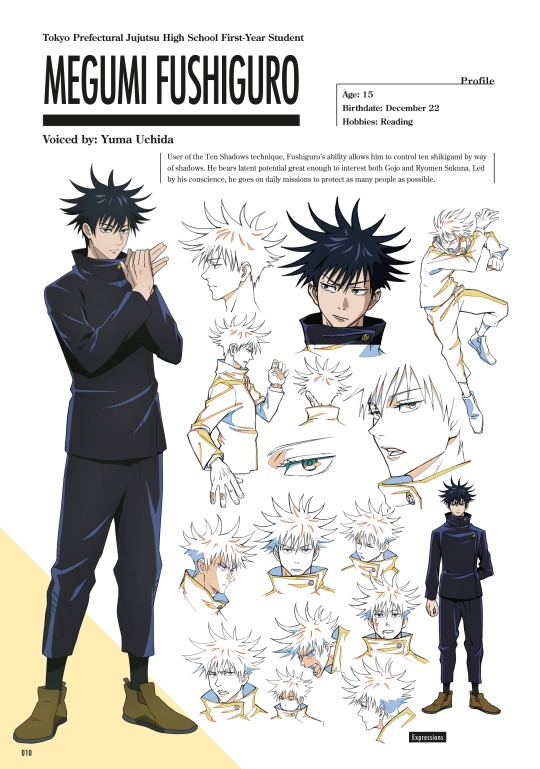

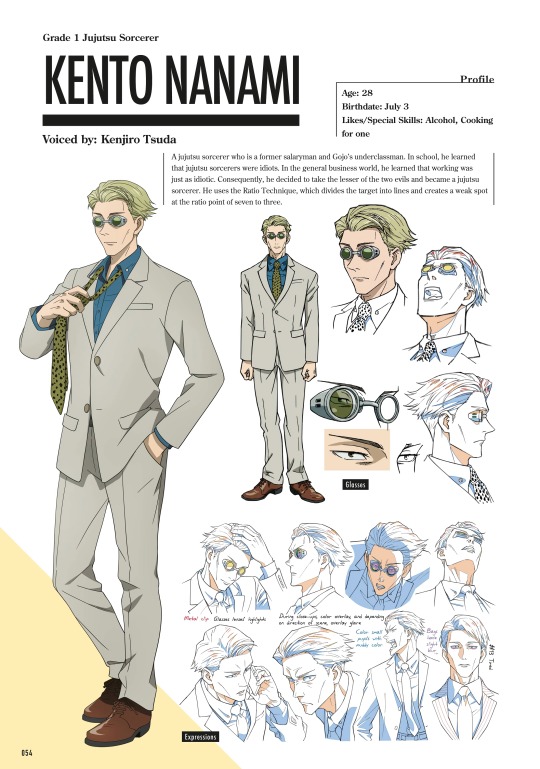
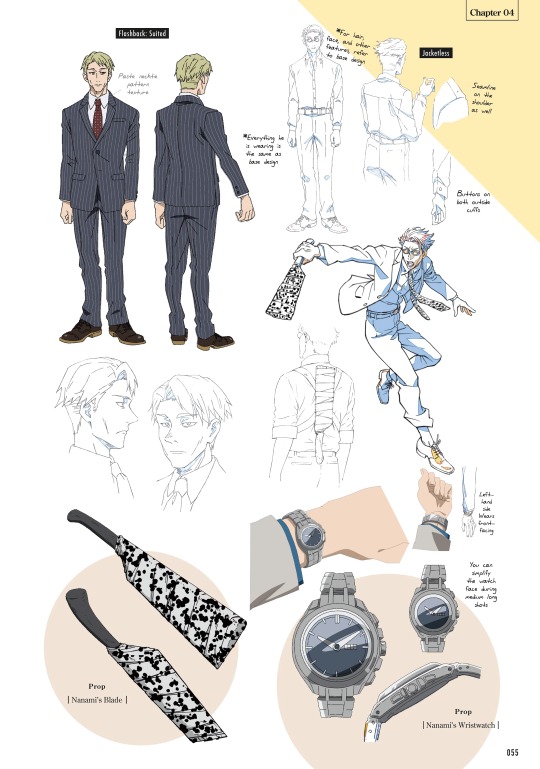








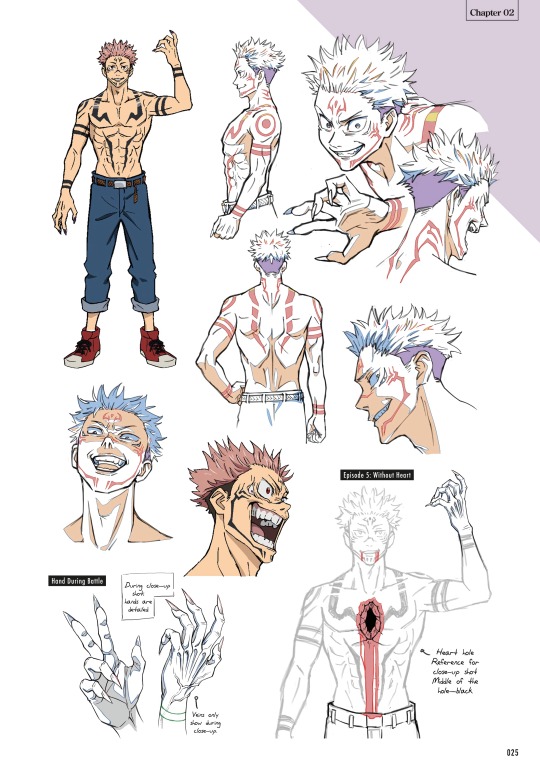
Character design :-Jujutsu Kaisen The Official anime guide : Season 1
Gojo Character design
#Jujutsu Kaisen The Official anime guide : Season 1#jujutsu kaisen#jjk#jujutsu#jjk anime#jjk official art#jjk illustration#anime#ryomen sukuna#sukuna#megumi fushiguro#nobara#itadori yuji#yuji itadori#nobara kugisaki#nanami kento#kento nanami#nanamin#fushiguro megumi#ijichi kiyotaka
899 notes
·
View notes